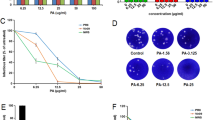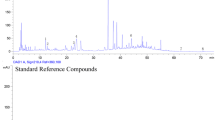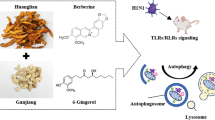Abstract
Patchouli alcohol (PA) is a kind of methanol extracted from traditional Chinese medicine Pogostemonis Herba. Our research aimed to observe the anti-influenza virus role of PA in vitro. 16HBE (human respiratory epithelial cell) was infected by H1N1 (A/FM1/1/47) to set the cell model. Then the 16HBE was co-cultivated with three kinds of immune cells: dendritic cells, macrophages, and monocytes, PA (the concentration is 10 μg/mL) was added as a treatment intervention for 24 h. The immune cells and the supernate were collected for RT-PCR and ELISA detection related to RLH (RIG-1-like helicases) pathway. Results showed that the IL-4 and IFN-γ in supernate were increased after H1N1 infection, and the PA treatment suppressed the expression of cytokines and the mRNA of RLH pathway. PA anti-influenza virus may through regulate the RLH singal pathway.
Graphical Abstract

Similar content being viewed by others
Avoid common mistakes on your manuscript.
Introduction
Influenza virus can cause pandemic disease around the world, and seriously threaten human’s health. According to statistics, over 10 % people on earth get the flu each year [1]. At present, human cannot control emergence and pandemic of the flu [2]. The current therapy of flu cannot acquire ideal effects. The current therapy is to use M2 protein inhibitor such as amantadine and neuraminidase inhibitor oseltamivir. But the viruses have three types and each type has several subtypes, and the antigenic drifts frequently, these affected the effects of treatment and vaccine [3].
Recent years, many scientists focus on Traditional Chinese Medicine to screen the anti-influenza virus drugs. Patchouli alcohol (PA) is a monomer extract from traditional Chinese medicine Pogostemonis Herba. PA has many pharmacological effects. Research showed that PA was a fragrant material used in decorative cosmetics and fine fragrances and so on [4]. PA can function as anti-inflammation drug, inhibiting the ear edema induced by xylene and suppressing the expression of inflammatory factor such as NF-κB, IL-1β in mice [5]. PA can also enhance the host immune responses against the influenza virus in mice [6].
RIG-1-like helicases (RLH) are involved in the induction of Type I interferon in response to viral infection [7]. It is a critical cytoplasmic double stranded RNA pattern receptor required for innate immune activation in response to viral infection. Activation of RIG-1 leads to type I interferon and inflammatory cytokine production [8]. RNA virus such as Influenza virus (IFV) generates dsRNA for replication in infected cell, RIG-1 was implicated in the recognition of the viral dsRNA, it can also discriminates virus and host RNAs. RIG-1 associate with IPS-1 (IFN promoter stimulator), and overexpression of IPS-1 induces the IFN production [9]. The production of IFN will play the roles of anti-influenza virus (Fig. 1).
In order to screen the effective anti-influenza monomer, our study was designed to observe the effect of PA anti-influenza role in vitro through the RLH pathway, hoping to reveal the mechanism, and promote the investigation of new anti-influenza drugs.
Materials and Methods
Cell Culture, Immune Cell Isolation, and Virus Inoculation
Cell line 16HBE was provided by Xiangfu Biotech Corporation in Shanghai, China.
The cells were cultured in RPMI-1640 containing 10 % heat-inactivated FBS (fetal bovine serum) at 37 °C and 5 % CO2 incubator. Immune cells were isolated from umbilical cord blood (Guangzhou Overseas Hospital). Three types of immune cell were isolated from umbilical cord blood. Monocytes were directly isolated used Lymphoprep. Mature DCs were stimulated by rhGM-CSF, rhIL-4 and rhTNF-α. Macrophages were stimulated by rhGM-GSF for 7 days. Virus of H1N1 influenza (A/FM1/1/47) was provided by Institute of Tropical Diseases, Southern Medical University of China.
Drug and its Original Ingredient
Patchouli alcohol and standard substance (molecular formula: C15H26O) were purchased from TCM Institute of Chinese Materia Medica, Nanjing. Patchouli alcohol was obtained from volatile and colorless solid, and the configuration was confirmed by X-ray (see Fig. 2). According to literature, the Patchouli alcohol dissolved in MeOH in which the concentration is 10 μg/mL, and showed 99.8 % inhibition of influenza virus and low cytotoxicity, so our experiment used the concentration of 10 μg/mL. According to literature, the Patchouli alcohol showed 99.8 % inhibition of influenza virus and low cytotoxicity when dissolved in MeOH in the concentration of 10 μg/mL [10].
Cell Model Establishment and Experimental Group
We used the “Millicell culture insert apparatus” to co-culture the cells, it’s a special culture bottle, and the up and down of this apparatus was separated by a semipermeable membrane. 16HBEs were underneath and the immune cells were above, between them was a free-exchanged membrane. After co-culture 12 h, 100× TCID50 of H1N1 (A/FM1/13) was added into the 16HBE to establish the infected cell model, after infected 2 h, 10 μg/mL of PA was added, and then cultured for 24 h. The experiment was divided into nine groups: DC with infected and uninfected (16HBE + DC + Virus and 16HBE + DC), macrophage with infected and uninfected (16HBE + macrophage + Virus and 16HBE + macrophage), monocyte with infected and uninfected (16HBE + monocyte + Virus and 16HBE + monocyte), PA was added to the three infected groups as treatment intervention (16HBE + DC + Virus + PA, 16HBE + macrophage + Virus + PA, 16HBE + monocyte + Virus + PA).
RT-PCR Detection of the RLH Pathway
Three types of immunocytes were collected after co-cultured and treatment intervention for PCR detection. The RLH pathway has many genes, we chose part of them to detect. The total RNA of these immunocytes was extracted by Trizol reagent (Tiangen Biotech Co., LTD, Beijing), and the cDNA reverse transcription kit and Real Master Mix also purchased from the above company for RT-PCR detection. The primers for PCR detection were designed and synthesized by Generay Biotech CO., Shanghai. The amplify times were read by qPCR instrument (Bio-Rad, USA), and each gene expression was analyzed by 2-∆∆Ct method. ∆Ct = Ct (target gene) − Ct(reference gene), and ∆∆Ct = ∆Ct (treatment group) − ∆Ct (control group). The data were described by (mean ± SD), and analyzed by SPSS 13.0 for windows.
Elisa Assay of the IFN-γ and IL-4 in the Cell Line Supernatant
The supernatant was collected after co-cultured and treatment intervention by PA for 24 h, and the IFN-γ and IL-4 of the supernatant solution were assayed by ELISA (enzyme-linked immunosorbent assay). The ELISA kit was purchased from ExCell Biology Incorporated, Shanghai. The absorbance was assayed at 450 nm using M680 microplate reader (Bio-Rad, USA).
Result
Cell Culture of 16HBE and Immune Cells
16HBE is the cell line, it was cultured at 37 °C and 5 % CO2 incubator, the cell culture medium is RPMI-1640 containing 10 % heat-inactivated FBS (Fig. 3). DC and Macrophages must be stimulated by rhGM-GSF and rhIL-4 (Fig. 3).
a Human respiratory epithelial cell, resuscitated from cell lines, eighth generation cells. b Immune cell DCs extracted from human cord blood, induced by 50 ng/mL rhGM-CSF for 7 days. DCx immunophenotyping was determined by FCM (Flow Cytometry Method). During this process, we detected the expression of CD83, CD86, and HLA-DR. a Cell line 16HBE (×200). b Dendritic cells (×200)
RLH Pathway Detected by RT-PCR
We choose part gene of RLH pathway to detect, they are RIG-1, IPS-1, Irf-3, and Irf-7. In our experiment, after H1N1 infecting, the RLH pathway in immune cells was up-regulated, especially in DCs and macrophages. The mRNA expression of the above six genes were significantly enhanced. PA treatment groups showed that the expression of these genes were down-regulated (see Fig. 4).
Expression of mRNA in of RLH pathway in 16HBE co-cultured with immune cells detected by RT-PCR(2−∆∆). a RIG-1 expression of each groups, in DC and monocyte groups, PA can down-regulate the raised RIG-1 gene expression; b IPS-1 expression of each groups, in monocyte group, virus up-regulate the IPS-1 expression; c IRF-3 expression of each groups, the changes were as a; d IRF-7 expression of each groups.(VS uninfected group, *P < 0.05; VS infected group, ∆P < 0.05)
IFN-γ and IL-4 in Cell Line Supernatant Assayed by ELISA
After infection procedure, the IFN-γ and IL-4 both increased significantly than the uninfected groups. Group in which 16HBE was co-cultured with immune cells showed anti-viral effects, they can reduce the level of these inflammatory factors, especially DC, and it has the strongest effect to reduce these factors. PA treatment can reduce the factors to anti-inflammation, groups which add PA showed that the IFN-γ and IL-4 were lower than other untreated infected groups. It means PA can reduce inflammatory response when influenza virus was invading (see Fig. 5).
Discussion
We should keep our memories of influenza virus because unanticipated outbreaks of influenza virus will repeatedly challenge human’s health. Threat of IFV is real exists and the effective anti-virus drugs must be developed [11]. At present, there is no specific medicine to anti-influenza, and the current drugs are seriously drug-resistant and have several side effects [12]. Facing the unknown outbreak of influenza, to develop more useful antibiotic becomes imperative.
Screen from the Traditional Chinese Medicine or Herbals to find an antibiotic is one of the research ideas to design the new drugs, such as Quercetin and Andrographolide. Research showed that the monomer Quercetin might be a potential substance to anti-viral and anti-inflammatory agents [13], and it has been demonstrated that it possessed a strong ani-influenza A/WS/33 virus by indirectly interacted virus particles [14]. The extract of Andrographolide also has a defensed effect when influenza virus invading [15, 16].
Patchouli alcohol (PA, C15H26O) was a monomer extracted from Chinese Medicine Pogostemon cablin. Research showed that this monomer can directly anti-influenza virus in vitro [10]. Our experiment showed that, the inflammatory factors IFN-γ and IL-4 in supernatant of co-culture cells system were elevated after infection by H1N1, and PA could reduce these factors in treatment groups. It suggested that PA was anti-inflammatory by down-regulating the inflammatory factors.
RLH (RIG-I-like helicases) pathway induces the antiviral innate immune response [17]. Research found that RIG-1 induce a type-1 IFN in vitro when virus invade, and RIG-1 has the function of recognition of viruses. Viral RNA in the viruses in the molecular signature was recognized by RIG-1 [18]. IPS-1 interacts with TRAF3 to activate TBK-1 [19], and TBK1 phosphorylate IRF3 and IRF7, and then induce the IFN-α response [20]. IPS-1 also suggests a role for inducing the virus to apoptosis. Our experiment showed that RLH pathway was up-regulated when virus infected the mRNA expression of RIG-1, TBK-1, and IPS-1 was all up-regulated. It means that virus invasion promote the cell to produce more IFN-α to play anti-virus role. PA treatment down-regulate the RLH pathway, it means the PA can enhance the ability of innate immune recognition and response, and restrain the expression of IFN-α inflammatory factor to attenuate the inflammatory responses.
References
Williams Jason R, Po-Yen Chen, Cho Cheng T, Chin Tom DY (2008) Influenza: prospect for prevention and control. Kaohsiung J Med Sci 18(9):421–434
Butler D (2009) Alarms ring over bird flu mutations. Nature 439(19):248
Mungall Bruce A, Xi-yan Xu, Klimov Alexander (2002) Surveillance of influenza isolates for susceptibility to neuraminidase inhibitors during the 2000–2002 influenza seasons. Virus Res 103:195–197
Bhatia SP, Letizia CS, Api AM (2008) Fragrance material review on patchouli alcohol. Food Chem Toxicol 46(11):S255–S256
Li Yu-Cui, Xian Yan-Fang, Ip Siu-Po, Zi-Ren Su, Ji-Yan Su, He Jing-jin, Xie Qing-Feng, Lai Xiao-Ping, Lin Zhi-Xiu (2011) Anti-inflammatory activity of patchouli alcohol isolated from Pogostemonis Herba in animal models. Fitoterapia 82(8):1295–1301
Li Yu-Cui, Peng Shao-Zhong, Chen Hai-Ming, Zhang Feng-Xue, Pei-Ping Xu, Xie Jian-Hui, He Jing-Jin, Chen Jian-Nan, Lai Xiao-Ping, Zi-Ren Su (2012) Oral administration of patchouli alcohol isolated from Pogostemonis Herba augments protection against influenza viral infection in mice. Int Immunopharmacol 12(1):194–301
Bradford Bowzard J, Ranjan Priya, Sambhara Suryaprakash, Fujita Takashi (2009) Antiviral defense: RIG-lng the immune system to STING. Cytokine Growth Fact Rev 20(1):1–5
Luke Jeremy M, Simon Gregory G, Soederholm Jonas, Errett John S, August Thomas, Gale Michael Jr, Hodgson Clague P, Williams James A (2011) Coexpressed RIG-I agonist enhances humoral immune response to influenza virus DNA vaccine. J Virol 85(3):1370–1383
Takeuchi Osamu, Akira Shizuo (2008) MDA5/RIG-1 and virus recognition. Curr Opin Immunol 20(1):17–22
Kiyohara Hiroaki, Ichino Chikara, Kawamura Yuka, Nagai Takayuki, Sato Noriko, Yamada Haruki (2011) Patchouli alcohol: in vitro direct anti-influenza virus sesquiterpene in Pogostemon cablin Benth. J Nat Med 66(4):583–590
Combadiere B, Siberil S, Duffy D (2010) Keeping the memory of influenza viruses. Pathol Biol (Paris) 58:e79–e86
Stephenson I, Nicholson KG (1999) Chemotherapeutic control of influenza. J Antimicrob Chemother 44:6–10
Zhang L, Cheng YX, Liu AL, Wang HD, Wang YL, Du GH (2010) Antioxidant, anti-inflammatory and anti-influenza properties of components from Chaenomeles speciosa. Molecules 15(11):8507–8517
Choi HJ, Kim JH, Lee CH, Ahn YJ, Song JH, Baek SH, Kwon DH (2009) Antiviral activity of quercetin 7-rhamnoside against porcine epidemic diarrhea virus. Antiviral Res 81(1):77–81
Levita J, Nawawi A, Mutalib A, Ibrahim S (2010) Andrographolide: a review of its anti-inflammatory activity via inhibition of NF-kappaB activation from computational chemistry aspects. Int J Pharmacol 6:569–576
Levita J, Widiastuti NM, Nugrahani I, Musadad A, Nawawi A, Mutalib A, Ibrahim S (2011) Indirect iodination on the vinyl double bond of andrographolide. Int J Chem 3:p47
Thompson Alex JV, Locarnini Stephen A (2007) Toll-like receptors, RIG-1-like RNA helicases and the antiviral innate immune response. Immunol Cell Biol 85:435–445
Hornung V, Ellegast J, Kim S, Brzozka K, Jung A, Kato H, Poeck H, Akira S, Conzelmann KK, Schlee M, Endres S, Hartmann G (2006) 5′-Triphosphate RNA is the ligand for RIG-I. Science 314(5801):994–997
Saha SK, Pietras EM, He JQ, Kang JR, Liu SY, Oganesyan G, Shahangian A, Zarnegar B, Shiba TL, Wang Yao, Cheng GH (2006) Regulation of antiviral responses by a direct and specific interaction between TRAF3 and Cardif. EMBO J 25(14):3257–3263
Kawai T, Akira S (2007) Antiviral signaling through pattern recognition receptors. J Biochem (Tokyo) 141:137–145
Acknowledgments
This study was supported by the National Natural Science Foundation of China (No. 30973693, No. 81273616) and the Research Fund for the Doctoral Program of Higher Education of China (No. 20104401110003).
Author information
Authors and Affiliations
Corresponding author
Additional information
Xian-Lin Wu and Da-Hong Ju contributed equally to this article.
Rights and permissions
About this article
Cite this article
Wu, XL., Ju, DH., Chen, J. et al. Immunologic Mechanism of Patchouli Alcohol Anti-H1N1 Influenza Virus May Through Regulation of the RLH Signal Pathway In Vitro. Curr Microbiol 67, 431–436 (2013). https://doi.org/10.1007/s00284-013-0381-y
Received:
Accepted:
Published:
Issue Date:
DOI: https://doi.org/10.1007/s00284-013-0381-y









